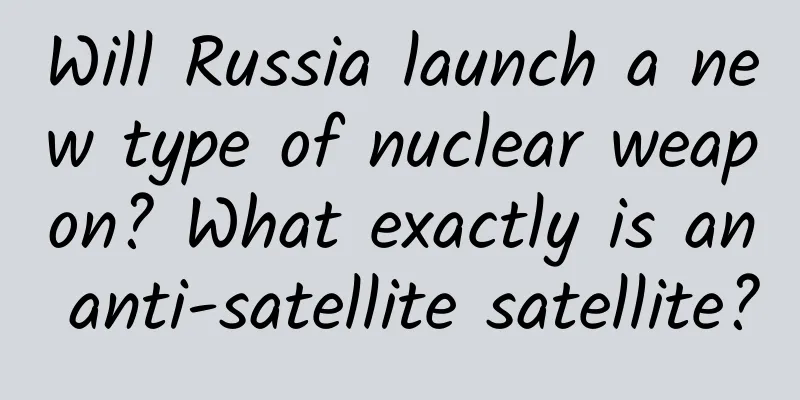Will Russia launch a new type of nuclear weapon? What exactly is an anti-satellite satellite?

|
Any weapon that can destroy satellites on a large scale would have extremely serious consequences: if the United States' early warning satellites over the Pacific Ocean were attacked, it could trigger a serious security escalation, and such an incident could cause Washington to panic, or even be misunderstood as a precursor to a nuclear attack. During the Cold War, the United States and the Soviet Union reached a consensus that any interference with early warning satellites would be regarded as a sign of an impending nuclear attack. Written by | Lee Hyun-hwan Russia may be developing a "disturbing" new anti-satellite weapon that will be launched this year. This information was revealed by a US intelligence source and widely reported by the media, causing "panic and confusion in Washington." The report said that Russia is mastering a space-based capability to attack satellites using nuclear weapons. The source of the information comes from US officials. John Kirby, a spokesman for the White House National Security Council, said, "It can be confirmed that this is related to the anti-satellite capability that Russia is developing." The White House believes that this is most likely an anti-satellite weapon that Russia is developing. It is itself a satellite that can attack satellites in other orbits. Figure丨Related reports A picture of space war unfolds. The overall concern stems from the destructive effects of anti-satellite weapons: they could destroy low-Earth orbit and threaten all artificial satellites indiscriminately. "If someone dares to detonate a nuclear weapon in the upper atmosphere or in space, it would almost mean the end of the availability of global public resources," said Major General Michael Traut, head of the German Space Command, commenting on the news. "No one would be immune to such actions - whether it is a Chinese satellite, a Russian satellite, an American satellite or a European satellite." The "rumored" weapon can bring about a massive energy explosion, causing damage to satellites in orbit over a large area, and many speculations point to nuclear electromagnetic pulse (NEMP). The White House also called for calm despite the continuous emergence of related reports. "While Russia's pursuit of this specific capability is disturbing, there is no direct threat to anyone's safety at this time," John Kirby told the media. Major General Trout believes that there are currently "more questions than answers" regarding the reported Russian space nuclear weapons, but what has been reported so far is worrying enough. Although Russian President Vladimir Putin denied that the country plans to deploy nuclear weapons in space when he met with defense ministers in Moscow, this did not eliminate the doubts caused by rumors of space nuclear weapons. After all, today’s space is nothing like the space of the Cold War. Thousands of satellites orbit the Earth, and a conflict in space would have irreversible consequences for military and civilian populations around the world. A killer weapon born during the Cold War In fact, the electromagnetic pulse (EMP), now known as the "second atomic bomb", is not a new weapon. It was born by accident during the Cold War. At that time, the United States and the Soviet Union discovered in successive nuclear weapons tests that after a nuclear explosion, electronic components such as communication equipment and radar within a certain range would be damaged to varying degrees. For example, in July 1962, the United States detonated a nuclear bomb 400 kilometers above the Pacific Ocean. The purpose was to verify the explosion capability of the nuclear bomb, but it accidentally caused more than 300 street lights to go out on the island of Hawaii, 1,445 kilometers away, and triggered multiple alarms. Even Australia, 5,000 kilometers away, felt the impact of the explosion. Figure|1962 nuclear test, the sky seen from Hawaii 1445 kilometers away The effects of the explosion also unexpectedly spread to space. Just four days later, Britain's first artificial satellite, Ariel-1, stopped operating without warning after having been operating stably for several months. Subsequent investigations showed that the radiation belt generated by the nuclear bomb explosion destroyed the satellite. In another case, a Soviet hydrogen bomb test also caused damage to electronic equipment over a radius of thousands of kilometers, including damage to Soviet radar and disruption of communication lines. The answer has been gradually revealed after years of research. Scientists have discovered that after a nuclear weapon explodes, in addition to shock waves, light radiation, nuclear radiation and radioactive contamination, it also produces a magnetic pulse effect. This is also the source of the core capability of EMP weapons. From a technical perspective, EMP bombs can release powerful electromagnetic radiation in a short period of time, causing damage to or rendering ineffective electronic equipment over a wide range. The instantaneous burst and huge energy of this radiation make it an ideal choice for destroying enemy equipment on the battlefield. To this end, the United States and the Soviet Union once sent nuclear bombs into space for explosion tests. The electromagnetic pulses generated caused malfunctions in other satellites, and continued to study this as a form of space warfare. With the widespread use of electronic information systems on the battlefield, especially the popularization of high-precision sensors and electronic equipment, they are becoming more sensitive and vulnerable to EMP weapons while pursuing automation, miniaturization and refinement. For example, EMP weapons can first destroy the enemy's radar and air defense systems, opening a breakthrough for subsequent offensive operations. But when applied to space scenarios, the situation becomes more complicated and difficult to control. The main problem is that it will cause indiscriminate damage to all electronic equipment within the effective range, including enemy and domestic ones. In addition, once nuclear weapons are used in space, the charged particles produced are easily captured by the Earth's Van Allen radiation belts. Any satellite passing near the radiation belts will be exposed to strong radiation and thus destroyed. Such charged particles will stay in the radiation belts for a long time, making it impossible for both enemies and friends to use the airspace. Let's talk about the issue of space warfare. The space industry has a strong military background and international competition. Since mankind entered the space age, countries have never stopped militarizing space. Among them, anti-satellite technology is the core capability of space warfare. In the late 1950s, the US military used bombers to test-fire not-so-accurate anti-satellite weapons at high altitudes. The Soviet Union's anti-satellite weapon tests in the 1960s also failed to achieve satisfactory results. The conflicts of that era gradually resolved in subsequent changes in the situation, until the recent conflicts once again raised the threat of space war. All it takes is one war to destroy space Modern warfare cannot be carried out without the support of reconnaissance, navigation and communication satellites. After the outbreak of the Russia-Ukraine conflict, Musk's company also provided communication support to the conflict area by launching small Starlink broadband satellites. Compared with their critical strategic significance, satellites are quite fragile. They fly along almost fixed orbits, and any collision is fatal, making them easy targets for enemy missiles and other anti-satellite systems. Destroying the enemy's satellite first can often have a huge strategic impact, but the situation becomes more complicated if the satellite is destroyed roughly. Unlike an airplane, a satellite will not fall to the ground after being destroyed, but will turn into thousands of fragments, threatening other spacecraft in orbit around the earth. Figure|Schematic diagram of space debris In November 2021, Russia destroyed one of its own satellites by launching a missile, and the debris from the collision was randomly scattered near the orbit of the International Space Station (ISS). As the latter orbits the Earth 16 times a day, the debris left an indelible safety hazard near the orbit. At that time, almost every 93 minutes, the ground control center notified the astronauts that they were about to pass through the debris cloud again, and advised them to close the hatch and pray for good luck. This risk is particularly acute today, when thousands of satellites orbit the Earth and become part of our daily lives. Donald J. Kessler, an astrophysicist and famous scholar on space junk, once proposed the Kessler Syndrome: as space junk in low-Earth orbit continues to increase, collisions between space objects will produce a large amount of debris, which will increase the probability of future collisions, forming a self-reinforcing chain reaction. This theory originally summarized the threat posed by the increase in space debris, taking into account that the outbreak of space war would accelerate this process exponentially, resulting in an explosive increase in the density of the debris cloud in orbit, posing a serious threat to all spacecraft passing through the area, and may even make certain orbital areas unsafe for use. "If someone makes a rational calculation, no one would use such a weapon in space," said the head of the German Space Command in response to recent discussions about nuclear weapons in space. "The consequence of an attack would be to turn thousands of satellites in orbit into garbage and create a dense debris field." Some US officials analyzed that since space nuclear weapons will launch indiscriminate attacks on satellites in orbit, Russian satellites will also suffer the same damage, so it is almost certain that this is Russia's "final blow." Chinese military expert Zhang Xuefeng provided another perspective in an interview with the Global Times. He believes that it is not clear whether Russia is developing space-based anti-satellite weapons, but the X-37B, which the United States has launched many times, is a space-based system with anti-satellite capabilities, and the United States has always avoided talking about this. In the view of Jonathan McDowell, an astrophysicist at the Harvard Smithsonian Center for Astrophysics, the possibility of space war not only exists, but is also quite high. Since humans began space exploration, there have been military activities in space, but mainly launching spy and communication satellites to support military operations on Earth. Today, more and more militaries, including the US military, are studying the possibility of space conflict. If a conflict occurs on Earth, since military forces on Earth are highly dependent on space assets, the conflict is likely to expand to space. Avoid escalating war During the Cold War, satellites in Earth orbit were almost entirely controlled by the United States and the Soviet Union, but today's space is no longer what it used to be. Dozens of countries and hundreds of commercial companies are active in space, and the complex status quo has become a source of vulnerability, which may break the existing balance. Especially in extreme situations such as war and conflict, the focus of global attention will go far beyond the satellites themselves, but will be on the stability of a wider situation. Analogous to the conflicts between nuclear-armed countries in the past, non-war actions may also have serious consequences. For example, attacks on satellite networks will not cause casualties due to the failure of satellite networks, but the danger is not small. Brian Weeden of the Secure World Foundation warned that if the US early warning satellites over the Pacific Ocean were attacked, it could trigger a serious security escalation. Such an incident could cause panic in Washington and could even be misunderstood as a precursor to a nuclear attack. Because during the Cold War, the United States and the Soviet Union reached a consensus that any interference with early warning satellites would be regarded as a signal that a nuclear attack was about to occur. Figure|International Space Station led by the United States and Russia It is undeniable that space is essentially a strategically important military domain. All countries want to prevent their opponents from entering space, so tensions are inevitable. How to avoid space war? This threat was born during the Cold War, and we can refer to the practices and ideas during the Cold War. During the space race between the United States and the Soviet Union, the Outer Space Treaty, adopted by the United Nations General Assembly in 1966, provided basic legal guidance for space activities, and some basic principles were established. In the field of space, which is currently not subject to strict legal constraints, consensus is still being maintained by countries. Michelle Hanlon, professor of aviation and space law at the University of Mississippi, likened it to the "Magna Carta" of space law. "In the space law community, we call this treaty the Magna Carta of space. It provides principled guidance that everyone has the right to freely use and explore space, that space belongs to all mankind, and that it should be used only for peaceful purposes." Hanlon is one of the few space law professionals in the world. Although the text of the treaty sounds abstract, it clearly prohibits certain actions, such as the placement of weapons of mass destruction and nuclear weapons in orbit or elsewhere in space. It was the most the international community could agree on during the Cold War in 1967. After the end of the Cold War, the core of space activities is to promote technological development through international cooperation, and countries generally hope to maintain this spirit of cooperation. International cooperation and collaboration are ongoing, and many scientific and research missions are completed through multinational cooperation. The most typical example is the International Space Station, where astronauts from the United States and Russia have long been performing missions at the same time. Today, the risk of space war has increased again, showing that peace in the space field is hard-won and all parties are still maintaining a fragile balance. As John Shaw, former deputy commander of the US Space Command, said, the world has entered the "third era of space." The first era was during the Cold War, when space was dominated by superpowers; in the second stage, private companies became more prominent in providing services such as communications and television in space; in the third era, space services are becoming more and more closely intertwined with civilian life. And the most important feature is that threats and potential conflicts will persist. Reference Links [1] https://www.washingtonpost.com/technology/2024/02/15/space-weapons-russia-china-starlink/ [2] https://www.economist.com/international/2024/01/31/america-china-and-russia-are-locked-in-a-new-struggle-over-space [3] https://www.youtube.com/watch?v=2KC67LjeJfo This article is supported by the Science Popularization China Starry Sky Project Produced by: China Association for Science and Technology Department of Science Popularization Producer: China Science and Technology Press Co., Ltd., Beijing Zhongke Xinghe Culture Media Co., Ltd.
1. Go to the "Featured Column" at the bottom of the menu of the "Fanpu" WeChat public account to read a series of popular science articles on different topics. 2. Fanpu provides a function to search articles by month. Follow the official account and reply with the four-digit year + month, such as "1903", to get the article index for March 2019, and so on. Copyright statement: Personal forwarding is welcome. Any form of media or organization is not allowed to reprint or excerpt without authorization. For reprint authorization, please contact the backstage of the "Fanpu" WeChat public account. |
Recommend
Can sighing often lead to "poisoning"?
Source: Youlai Healthy Life...
What are the advantages of Taobao mini programs? How about Taobao mini program?
Q: What are the advantages of Taobao Mini Program...
Hulunbuir Mini Program Customization Company, how much does it cost to customize a tattoo mini program?
There are two types of customization for Hulunbui...
A practical guide to creativity for Chinese trend illustrators
: : : : : : : : : : : : : : : : : : : : : : : : : ...
Analysis of McDonald’s marketing code!
"Would you like some cilantro with ice cream...
How to optimize account structure knowledge? What is the basic structure of a bidding account?
Many people don’t know how to optimize a Baidu pr...
QuestMobile: Monthly active users of domestic car apps released, BYD tops the list, Xiaomi enters the top five
In today's intelligent era, smart car apps ha...
Android Aiyouman v2.1.3 All comics free to read_Taoduoduo
Android Aiyouman v2.1.3 All comics free to read_T...
Why do cacti have thorns?
When you think of cactus, what comes to mind firs...
European operator: Apple may release iPhone 12 on October 13
According to whistleblowers, Apple may hold an iP...
National Medical Products Administration: 2024 Annual Drug Review Report
In 2024, the number of drug registration applicat...
Is wild Cordyceps suitable for women?
As you know, many nutrients are not suitable for ...
Every smooth day, they are protecting you
Mixed Knowledge Specially designed to cure confus...
Can Valve's pre-sale of handheld consoles be a catalyst for Steam's development?
Players who are familiar with PC games are also f...
Product promotion: How to advertise?
A very important part of advertising is the selec...









